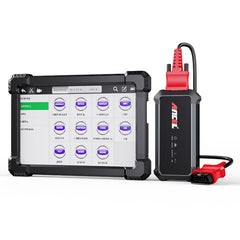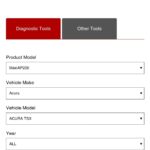For enthusiasts and owners of classic cars from 1995 and earlier, maintaining these vehicles often requires a blend of traditional know-how and modern diagnostic techniques. While newer cars boast sophisticated onboard diagnostic systems, older models present a unique challenge. This is where understanding car code scanners, particularly for 1995 and older vehicles, becomes essential. These scanners act as a vital tool, bridging the gap between the analog and digital worlds of automotive diagnostics, helping you understand your vintage vehicle’s health.
 ANCEL X7 automotive diagnostic scanner, ideal for diagnosing engine codes in 1995 and older cars.
ANCEL X7 automotive diagnostic scanner, ideal for diagnosing engine codes in 1995 and older cars.
Understanding OBD1 and OBD2: The Scanner Compatibility Question
The first crucial step in choosing a code scanner for your 1995 or older car is understanding the difference between OBD1 and OBD2 systems. On-Board Diagnostics (OBD) systems were introduced to monitor vehicle performance and emissions. OBD1 was the early standard, implemented differently by various manufacturers, leading to inconsistencies in diagnostic procedures and connector types. OBD2, standardized in 1996, brought uniformity, using a standard connector and diagnostic protocols.
Vehicles from 1995 and older primarily utilize OBD1. However, some 1995 models, particularly those manufactured for California and later federal standards, might have OBD2 systems, representing a transitional period in automotive technology. Therefore, determining whether your older car uses OBD1 or OBD2 is the initial hurdle. This distinction is critical because OBD2 scanners are not universally compatible with OBD1 systems without adapters, and vice versa. Some advanced scanners, however, are designed to support both protocols, offering broader compatibility for vintage and classic car owners.
Key Features to Prioritize in a Scanner for Classic Cars
When selecting a “1995 And Older Car Code Scanner,” certain features become particularly important to ensure effective diagnostics:
- OBD1/OBD2 Compatibility: Ideally, the scanner should handle both OBD1 and OBD2 protocols, or at least be specifically compatible with the OBD1 system of your vehicle’s make and model. If your car is definitively OBD1, ensure the scanner explicitly states OBD1 support for your car’s manufacturer (e.g., GM OBD1, Ford OBD1, etc.) as OBD1 was not standardized across brands.
- Code Reading and Clearing: At a minimum, the scanner must be capable of reading diagnostic trouble codes (DTCs) and clearing them. This basic functionality allows you to identify the source of the check engine light and reset it after repairs.
- Live Data Streaming: For deeper diagnostics, live data streaming is invaluable. This feature allows you to monitor real-time engine parameters, sensor readings, and other vital data, helping to pinpoint intermittent issues or diagnose performance problems beyond simple error codes.
- Freeze Frame Data: This feature captures a snapshot of sensor data when a DTC is triggered. Freeze frame data provides valuable context, showing the conditions under which a fault occurred, aiding in accurate diagnosis, especially useful for older cars where issues can be less straightforward.
- Ease of Use: Older car diagnostics can sometimes be more challenging. A scanner with a user-friendly interface, clear display, and intuitive navigation is crucial, especially for users who may not be professional mechanics.
User Interface and Display Considerations
The ease with which you can operate your “1995 and older car code scanner” directly impacts its usefulness. Look for scanners with:
- Clear and Readable Display: A screen that is easy to read in various lighting conditions is essential. Consider scanners with color displays or adjustable brightness for better visibility.
- Intuitive Navigation: The menu system should be straightforward and easy to navigate, allowing you to quickly access the functions you need without a steep learning curve.
- Durable Construction: A robust scanner that can withstand the garage environment is important. Look for scanners with sturdy housings and reliable button or touchscreen interfaces.
Durability and Build Quality for Longevity
Given that a “1995 and older car code scanner” might be used frequently during maintenance and troubleshooting of a classic car, durability is a key consideration. Opt for scanners known for their robust build quality. Features like drop resistance and sturdy connectors contribute to a longer lifespan, ensuring your tool remains reliable over years of use.
Balancing Cost and Diagnostic Capability
The price of car code scanners ranges widely. While budget is a factor, investing in a scanner with adequate features for your older car is often more economical in the long run. A more capable scanner can:
- Reduce Diagnostic Time: Pinpoint problems faster, saving time and labor costs if you rely on a mechanic.
- Enable DIY Repairs: Empower you to perform more repairs yourself, reducing reliance on professional services for basic issues.
- Prevent Costly Damage: Early diagnosis can prevent minor issues from escalating into major, expensive repairs.
While advanced professional-grade scanners exist, for most owners of 1995 and older cars, a mid-range scanner that balances OBD1/OBD2 compatibility, essential features, and user-friendliness offers the best value.
Effectively Using Your Code Scanner for Older Car Maintenance
Owning a “1995 and older car code scanner” is only the beginning. To maximize its benefit for your classic car:
- Regularly Scan for Codes: Make code scanning part of your routine maintenance, even if the check engine light isn’t on. Proactive scanning can reveal developing issues before they become critical.
- Understand Error Codes: Learn to interpret the diagnostic trouble codes (DTCs) your scanner provides. Resources like online DTC databases and repair manuals are invaluable for understanding what each code signifies.
- Use Live Data for Deeper Insight: Don’t just rely on error codes. Utilize live data to monitor engine performance, sensor readings, and identify anomalies that may not trigger a code immediately.
- Keep Your Scanner Software Updated: If your scanner allows for software updates, ensure it’s updated to maintain accuracy and compatibility with a broader range of vehicles, if applicable.
Comprehensive Car Care Beyond Code Scanning
Remember that while a “1995 and older car code scanner” is an invaluable diagnostic tool, it’s part of a broader approach to maintaining your classic car. Regular servicing, attention to age-related wear and tear, and using appropriate parts and fluids are equally crucial. A scanner helps you diagnose issues, but preventative maintenance and timely repairs are the cornerstones of keeping your vintage vehicle running smoothly for years to come.
Conclusion: Empowering Classic Car Owners with Diagnostics
Choosing the right “1995 and older car code scanner” is a significant step in effectively maintaining your classic vehicle. By understanding the nuances of OBD1 and OBD2, prioritizing key features, and learning to use your scanner effectively, you gain greater control over your car’s health. This empowers you to perform informed maintenance, troubleshoot issues efficiently, and ensure your beloved classic car remains on the road for years to come, blending the charm of vintage motoring with the benefits of modern diagnostics.
FAQs for 1995 and Older Car Code Scanners
Q1: Will a standard OBD2 scanner work on my 1995 or older car?
It depends. Most 1995 and older cars use OBD1. A standard OBD2 scanner will not directly work with OBD1 systems without an adapter, and even with an adapter, compatibility is not guaranteed for all functions. It’s best to either choose a scanner specifically designed for OBD1 for your car’s make or a scanner that explicitly supports both OBD1 and OBD2.
Q2: Are OBD1 scanners still available?
Yes, OBD1 scanners are still available. Some are dedicated OBD1 scanners for specific manufacturers (like GM, Ford, Chrysler OBD1), while others are combination OBD1/OBD2 scanners with broader compatibility.
Q3: What are the limitations of using a code scanner on a very old car (pre-1990s)?
Cars significantly older than 1995, especially pre-1990s, are increasingly likely to have very basic or no onboard diagnostic systems at all. While some early forms of engine management existed, they may not be OBD1 compliant or offer limited diagnostic data compared to later systems. Scanner compatibility and functionality will decrease the older the vehicle is. For very old cars, traditional mechanical diagnostic methods often remain essential.

